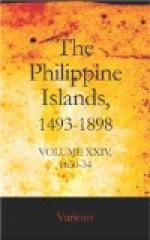religious, leaving his cause in the hands of God.
I leave it likewise; for, if we glance at the definitorio
which assembled there, there is no doubt that it was
one of the most sober-minded councils ever assembled
in the province. And even were there none other
in it than our father Fray Pedro de Arce, who presided
in it, he was sufficient to ensure that; but it was
much more creditable, for the others were very erudite.
Father Fray Juan Bautista de Montoya was the most
notable man in laws and moral causes that has been
in the islands, and was no less a very great theologue.
Father Fray Esteban Carrillo, as we have said already,
was a great orator, and the other fathers were very
learned. On the part of our father provincial,
it was known that he was very devout, very punctual
in attending to his obligations and that his first
term was considered as most successful. Hence,
without taking from anyone what belongs to him, we
leave this matter with God, who has already judged
it, and He has been pleased to take all those concerned
in it. Bishop Fray Pedro de Agurto was at his
bishopric in Sugbu at this time. He was desirous
of remedying what was already becoming established,
and even left his city for that purpose. But
when he reached Manila, he found that there was no
remedy. He sorrowed greatly over this blow at
the order, for, as the true religious that he was,
he felt, as keenly as death, whatever misfortune came
upon the order. In the world this proceeding
was discussed with the charity that is exercised in
other things; but, when everything was over, it was
also erased from memory—and more, as the
government of our father Fray Pedro de Arce followed
immediately, who exercised the office of rector-provincial
for that one and one-half years, and his fame and
well-known virtue filled everything with fragrance
and good-will.
[The order of discalced Augustinians in Spain petition
for leave to go to the islands in 1605. The petition
granted, a number of them set out; and, after waiting
at Sevilla for some time for vessels, reach Mexico,
where they are entreated to found a convent. Refusing
this request, however, they continue on their journey,
reaching the Philippines, in 1606, under the leadership
of Juan de San Jeronimo. “They were given
a house outside the city in a garden [11] that had
belonged to Don Pedro de Acuna, who governed these
islands.... But those who treated the said fathers
most generously were Ours, for we gave them our best
and brightest jewel, namely, San Nicolas, allowing
them to found their convent in his name. This
meant wholly to enrich them and to leave us poor.”
Further, a layman named Don Bernardino, captain and
castellan of the port of Manila, builds a convent for
the new order “sufficient for forty religious.”
At death he and his wife also leave money to continue
the work, and the new order begins to multiply.]




